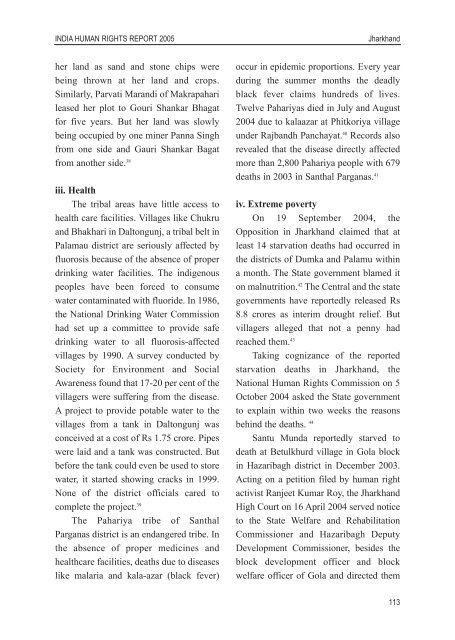annual report print final.qxd - Asian Centre for Human Rights
annual report print final.qxd - Asian Centre for Human Rights
annual report print final.qxd - Asian Centre for Human Rights
You also want an ePaper? Increase the reach of your titles
YUMPU automatically turns print PDFs into web optimized ePapers that Google loves.
INDIA HUMAN RIGHTS REPORT 2005 Jharkhand<br />
her land as sand and stone chips were<br />
being thrown at her land and crops.<br />
Similarly, Parvati Marandi of Makrapahari<br />
leased her plot to Gouri Shankar Bhagat<br />
<strong>for</strong> five years. But her land was slowly<br />
being occupied by one miner Panna Singh<br />
from one side and Gauri Shankar Bagat<br />
from another side. 38<br />
iii. Health<br />
The tribal areas have little access to<br />
health care facilities. Villages like Chukru<br />
and Bhakhari in Daltongunj, a tribal belt in<br />
Palamau district are seriously affected by<br />
fluorosis because of the absence of proper<br />
drinking water facilities. The indigenous<br />
peoples have been <strong>for</strong>ced to consume<br />
water contaminated with fluoride. In 1986,<br />
the National Drinking Water Commission<br />
had set up a committee to provide safe<br />
drinking water to all fluorosis-affected<br />
villages by 1990. A survey conducted by<br />
Society <strong>for</strong> Environment and Social<br />
Awareness found that 17-20 per cent of the<br />
villagers were suffering from the disease.<br />
A project to provide potable water to the<br />
villages from a tank in Daltongunj was<br />
conceived at a cost of Rs 1.75 crore. Pipes<br />
were laid and a tank was constructed. But<br />
be<strong>for</strong>e the tank could even be used to store<br />
water, it started showing cracks in 1999.<br />
None of the district officials cared to<br />
complete the project. 39<br />
The Pahariya tribe of Santhal<br />
Parganas district is an endangered tribe. In<br />
the absence of proper medicines and<br />
healthcare facilities, deaths due to diseases<br />
like malaria and kala-azar (black fever)<br />
occur in epidemic proportions. Every year<br />
during the summer months the deadly<br />
black fever claims hundreds of lives.<br />
Twelve Pahariyas died in July and August<br />
2004 due to kalaazar at Phitkoriya village<br />
under Rajbandh Panchayat. 40 Records also<br />
revealed that the disease directly affected<br />
more than 2,800 Pahariya people with 679<br />
deaths in 2003 in Santhal Parganas. 41<br />
iv. Extreme poverty<br />
On 19 September 2004, the<br />
Opposition in Jharkhand claimed that at<br />
least 14 starvation deaths had occurred in<br />
the districts of Dumka and Palamu within<br />
a month. The State government blamed it<br />
on malnutrition. 42 The Central and the state<br />
governments have <strong>report</strong>edly released Rs<br />
8.8 crores as interim drought relief. But<br />
villagers alleged that not a penny had<br />
reached them. 43<br />
Taking cognizance of the <strong>report</strong>ed<br />
starvation deaths in Jharkhand, the<br />
National <strong>Human</strong> <strong>Rights</strong> Commission on 5<br />
October 2004 asked the State government<br />
to explain within two weeks the reasons<br />
behind the deaths. 44<br />
Santu Munda <strong>report</strong>edly starved to<br />
death at Betulkhurd village in Gola block<br />
in Hazaribagh district in December 2003.<br />
Acting on a petition filed by human right<br />
activist Ranjeet Kumar Roy, the Jharkhand<br />
High Court on 16 April 2004 served notice<br />
to the State Welfare and Rehabilitation<br />
Commissioner and Hazaribagh Deputy<br />
Development Commissioner, besides the<br />
block development officer and block<br />
welfare officer of Gola and directed them<br />
113



